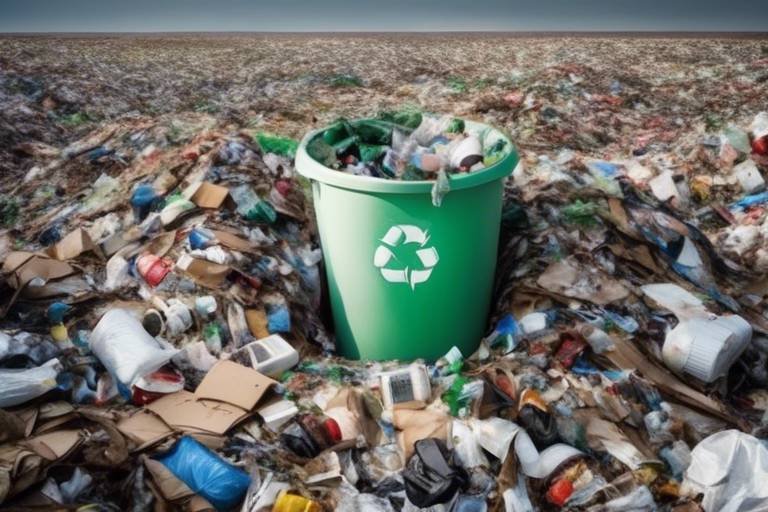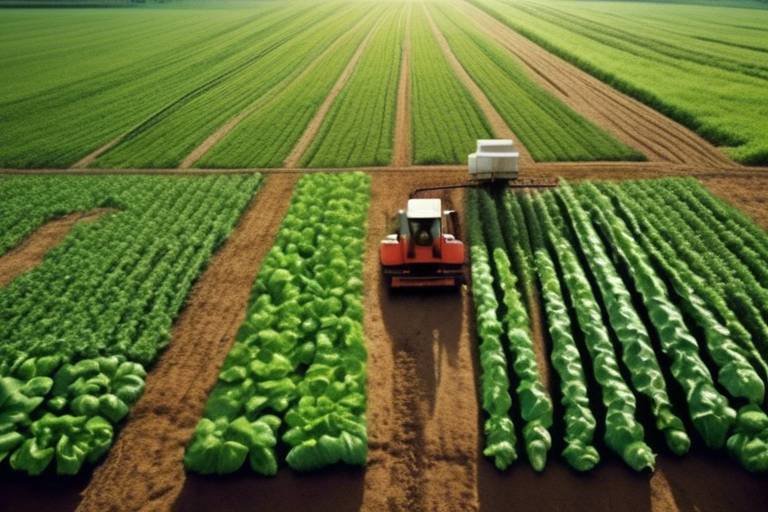Why Climate Change is a Double-Edged Sword for Fisheries
Climate change is often viewed as a looming threat, casting a long shadow over our planet’s ecosystems. But when it comes to fisheries, the situation is more like a double-edged sword. On one side, we see the challenges that arise from shifting temperatures and changing ocean conditions, threatening the very fabric of marine life. On the other side, there are unexpected opportunities for adaptation and growth within certain fish populations. This complex interplay creates a scenario where the impacts of climate change are not just detrimental, but also transformative for fishing communities around the globe.
As the climate warms, fish populations are experiencing a rollercoaster of changes. Altered habitats, spawning cycles, and migration patterns are reshaping the dynamics of marine ecosystems. For instance, certain species may find their traditional spawning grounds unsuitable, leading to potential declines. Conversely, some fish may thrive in warmer waters, expanding their range and altering the competition landscape. This push and pull creates a scenario where the fishing industry must adapt swiftly to the new normal, making it imperative for communities to stay informed and agile.
Moreover, the rising temperatures and increased ocean acidity are not just affecting fish; they are also disrupting entire marine ecosystems. As these changes unfold, the balance of species is thrown into disarray, which can have cascading effects on food webs. For example, as the primary producers in these ecosystems—like phytoplankton—react to changing conditions, the impact can ripple through the food chain, affecting everything from small fish to larger predators. This shift can lead to decreased fish stocks, making it harder for fishing communities to thrive.
One of the most critical ecosystems affected by climate change is coral reefs. These vibrant underwater gardens are not only beautiful but also serve as essential habitats for many fish species. Unfortunately, rising sea temperatures and acidification are leading to coral bleaching and degradation. This loss of biodiversity is alarming; as coral reefs deteriorate, the fish that depend on them for shelter and food are also at risk. The implications for fisheries are dire, as many communities rely on these ecosystems for their livelihoods.
The degradation of coral reefs due to climate change results in diminished biodiversity, which can destabilize fish populations and reduce the resilience of marine ecosystems. When species diversity declines, the entire ecosystem becomes more vulnerable to diseases and environmental changes. This fragility can lead to a domino effect, where the loss of one species impacts others, creating a cycle of decline that can be hard to reverse.
Fortunately, there is hope on the horizon. Restoration efforts for coral reefs are gaining momentum, with many organizations and communities working together to mitigate the effects of climate change. These initiatives are crucial for maintaining biodiversity and supporting fisheries in affected regions. By actively engaging in restoration, communities can not only help revive these vital ecosystems but also ensure their long-term sustainability. It’s a classic case of turning the tide—literally and figuratively—against climate change.
Another significant aspect of climate change is the alteration of ocean currents. These currents play a crucial role in nutrient distribution, which directly influences fish feeding patterns and availability. As currents shift, they can lead to the concentration of nutrients in some areas while leaving others barren. This change can have profound implications for fisheries, as fish populations may migrate to follow the nutrients, leaving some fishing communities struggling to adapt to the new conditions.
The economic repercussions of climate change on fisheries are profound. Fishing communities face challenges as the availability of fish fluctuates and market conditions shift. The need for adaptation strategies becomes paramount to ensure economic viability and food security. For instance, some communities may need to diversify their fishing practices or explore alternative livelihoods to cope with the changing landscape.
Fishing communities are on the front lines of climate change, facing the brunt of its impacts. As fish availability declines, many families struggle to make ends meet. The uncertainty of market conditions can lead to financial strain, making it crucial for these communities to develop resilience. Adaptation strategies, such as sustainable fishing practices and community-led initiatives, are essential in navigating this turbulent environment.
To effectively address the impacts of climate change on fisheries, robust policy and management strategies are essential. Governments and organizations must work together to promote sustainable practices that not only protect marine ecosystems but also support the livelihoods of fishing communities. By prioritizing resilience and sustainability, we can create a framework that allows fisheries to thrive even in the face of climate change.
- How does climate change affect fish populations? Climate change alters habitats, spawning cycles, and migration patterns, leading to potential declines in some species while providing opportunities for others.
- What are the effects of coral reef degradation? Coral reef degradation results in diminished biodiversity, destabilizing fish populations and reducing the resilience of marine ecosystems.
- What can be done to restore coral reefs? Restoration efforts, including community engagement and sustainable practices, are critical to mitigating the effects of climate change on coral reefs.
- How do changes in ocean currents impact fisheries? Altered ocean currents can affect nutrient distribution, influencing fish feeding patterns and availability, which has significant implications for fisheries.

Impact on Fish Populations
Climate change is shaking up the underwater world in ways that are both startling and profound. As temperatures rise, the habitats that fish call home are shifting, leading to a ripple effect throughout marine ecosystems. Just imagine a bustling city, where suddenly all the roads change, and everyone has to find a new route to get to work. That's what fish populations are experiencing right now. Altered habitats, spawning cycles, and migration patterns are all being transformed, resulting in potential declines for some species while others may find new opportunities to thrive.
For instance, warmer waters can lead to a boom in certain fish species that prefer higher temperatures, such as tropical fish. However, this can spell disaster for species like cod and herring, which require cooler waters to survive. In essence, climate change acts like a double-edged sword, creating winners and losers in the fish population game. The struggle for survival becomes even more intense as fish compete for resources in their new environments.
Moreover, the spawning cycles of fish are also being impacted. Many fish species rely on specific environmental cues, such as water temperature and salinity, to determine the best time to reproduce. As climate change alters these cues, fish may spawn at suboptimal times, leading to reduced survival rates for their young. Just think about it: if a plant blooms too early in spring, it might get hit by a late frost. Similarly, fish that spawn too early or too late may find their offspring struggling to survive in a changing world.
Migration patterns are another area where climate change is making waves. Fish are known for their remarkable ability to migrate long distances to find food and suitable breeding grounds. However, as ocean temperatures rise and currents shift, these migratory routes are being disrupted. Fish may find themselves swimming in circles, unable to locate the rich feeding grounds they once relied on. This not only affects their health and population numbers but also has significant implications for fishing communities that depend on these species for their livelihoods.
To visualize the impact of climate change on fish populations, consider the following table:
| Fish Species | Current Status | Impact of Climate Change |
|---|---|---|
| Cod | Declining | Warmer waters reduce spawning success |
| Herring | At Risk | Changes in migration patterns affect population |
| Tropical Fish | Thriving | Increased temperatures favor growth |
As we can see, the effects of climate change on fish populations are complex and multifaceted. The challenges posed by altered habitats, spawning cycles, and migration patterns create a precarious situation for many species. It's crucial for us to understand these changes, not just for the sake of the fish, but for the fishing communities that rely on them for their survival. The future of our oceans and the livelihoods of countless people hang in the balance, reminding us that we must take action to address the looming threat of climate change.

Shifts in Marine Ecosystems
As the planet warms, the oceans are not simply standing still; they are undergoing a dramatic transformation that can be likened to a rapidly shifting chessboard. The pieces—the fish, the corals, and the myriad of other marine organisms—are all being forced to adapt to new positions, often at a pace that is hard to keep up with. This dynamic shift in marine ecosystems is largely driven by rising ocean temperatures and increased acidity, both byproducts of climate change. These changes disrupt the delicate balance that has existed for millennia, leading to significant consequences for marine life and fisheries.
One of the most alarming effects of these shifts is the alteration of food webs. As species migrate to cooler waters or adapt to new conditions, the relationships between predators and prey can become unbalanced. For instance, if a key species of plankton declines due to warmer waters, it can have a cascading effect on the entire food chain, impacting everything from small fish to large marine mammals. The implications for fisheries are profound, as fishermen may find themselves chasing fish stocks that are no longer where they used to be, or worse, facing a decline in available species altogether.
Moreover, the changes in marine ecosystems are not uniform across the globe. Some regions may experience a boom in certain fish populations, while others may see devastating declines. For example, warmer waters may favor species like tuna and mackerel, which thrive in higher temperatures, while cold-water species such as cod could face severe population declines. This uneven distribution of fish stocks can lead to conflict among fishing communities, as competition for dwindling resources intensifies.
To visualize these shifts, consider the following table that summarizes the effects of climate change on various marine species:
| Species | Current Status | Future Projections |
|---|---|---|
| Tuna | Increasing populations in warmer waters | Projected to expand range further north |
| Cod | Declining populations | Potential collapse in traditional fishing areas |
| Coral Reef Fish | Decreasing biodiversity | Risk of extinction for many species |
Additionally, the physical environment itself is changing. Ocean acidification, a direct result of increased carbon dioxide levels, affects the ability of marine organisms like corals and shellfish to build their skeletons and shells. This not only threatens the survival of these species but also the entire ecosystems that rely on them. The loss of coral reefs, often referred to as the "rainforests of the sea," is particularly concerning because they provide vital habitat for a vast array of marine life.
In conclusion, the shifts in marine ecosystems due to climate change are a complex web of interactions that present both challenges and opportunities. While some species may flourish, others are left struggling for survival. The future of fisheries will depend on our ability to understand these dynamics and adapt accordingly. As we navigate this uncertain waterscape, the resilience of marine ecosystems will be tested, and our fishing communities must be prepared to face the waves of change.
- How does climate change affect fish migration?
Fish migrate in search of optimal conditions, and as waters warm, many species are moving towards cooler regions, which can disrupt traditional fishing patterns. - What role do coral reefs play in marine ecosystems?
Coral reefs provide habitat and shelter for many marine species, and their degradation can lead to a loss of biodiversity and fish populations. - Can fisheries adapt to these changes?
Yes, but adaptation requires effective management strategies and policies to ensure sustainable practices and economic viability.

Coral Reef Degradation
Coral reefs are often referred to as the "rainforests of the sea" due to their incredible biodiversity and the vital role they play in marine ecosystems. However, climate change poses a significant threat to these underwater treasures. Rising ocean temperatures lead to a phenomenon known as coral bleaching, where corals expel the algae living in their tissues, causing them to lose their color and, more importantly, their primary source of nourishment. Without these algae, corals become more susceptible to disease and mortality, which can have devastating effects on the myriad of species that depend on these habitats for shelter and food.
The degradation of coral reefs not only impacts the marine life that inhabits them but also has profound implications for fisheries and the communities that rely on them. Many fish species, including commercially important ones, use coral reefs as breeding grounds and nurseries. When these reefs decline, so too does the abundance and diversity of fish populations. This can lead to a vicious cycle where diminished fish stocks affect local economies, particularly in coastal areas where fishing is a primary source of income.
To illustrate the impact of coral reef degradation, consider the following table that highlights the relationship between coral health and fish populations:
| Coral Health Status | Fish Species Diversity | Fishing Yield (kg/year) |
|---|---|---|
| Healthy | High | 5000 |
| Moderately Degraded | Medium | 3000 |
| Severely Degraded | Low | 1000 |
As shown in the table, the health of coral reefs directly correlates with the diversity and yield of fish species. A healthy reef can support a thriving fish population, while degraded reefs lead to a stark decline in both biodiversity and fishing yields. This is not just a problem for marine life; it also threatens the livelihoods of millions of people around the world who depend on fishing for their economic survival.
Efforts to combat coral reef degradation are underway globally, focusing on restoration and conservation. These initiatives aim to enhance coral resilience against climate change, which is crucial for maintaining biodiversity and supporting fisheries. By implementing measures such as marine protected areas, sustainable fishing practices, and community engagement in conservation efforts, we can help ensure that coral reefs continue to thrive for generations to come.

Effects on Biodiversity
The degradation of coral reefs due to climate change has profound , which can destabilize fish populations and reduce the resilience of marine ecosystems. Coral reefs, often referred to as the "rainforests of the sea," are home to an astonishing variety of marine life. When these ecosystems are compromised, the ripple effects can be devastating. For instance, as water temperatures rise and acidification occurs, coral bleaching becomes increasingly common. This phenomenon not only harms the corals themselves but also displaces the myriad species that depend on them for food and shelter.
Imagine a bustling city where the infrastructure begins to crumble. As buildings collapse, businesses shut down, and people are forced to relocate. This is akin to what happens in marine environments when coral reefs degrade. The fish that rely on these habitats for spawning and protection find themselves without a home, leading to declines in their populations. Moreover, the loss of biodiversity can create a domino effect that disrupts entire food webs. Predators may struggle to find prey, while smaller species may proliferate unchecked, leading to an imbalance that further threatens the ecosystem.
Research shows that biodiversity is crucial for the resilience of ecosystems. A diverse range of species can better withstand environmental changes and recover from disturbances. Conversely, a decline in biodiversity can lead to increased vulnerability. For instance, studies indicate that ecosystems with higher biodiversity are better equipped to handle stressors like climate change. When certain species disappear, the entire system becomes more fragile, making it less likely to bounce back from adverse conditions.
Furthermore, the loss of biodiversity not only affects marine life but also impacts human communities that rely on these ecosystems for their livelihoods. Fishing industries, tourism, and coastal protection all hinge on healthy marine biodiversity. As species decline, the availability of fish for consumption diminishes, leading to economic challenges for fishing communities. This situation creates a vicious cycle where the loss of biodiversity directly correlates with the loss of economic stability for those who depend on these resources.
To combat these challenges, conservation efforts are essential. Initiatives aimed at restoring coral reefs and protecting marine biodiversity can help mitigate the adverse effects of climate change. Strategies such as establishing marine protected areas, promoting sustainable fishing practices, and raising public awareness about the importance of biodiversity are crucial for fostering resilience in marine ecosystems. By prioritizing these efforts, we can not only protect the incredible diversity of life in our oceans but also secure the livelihoods of countless communities worldwide.
- What is coral bleaching? Coral bleaching occurs when corals lose their vibrant colors due to stress factors like increased water temperature, leading to the expulsion of symbiotic algae.
- How does biodiversity affect fishing? Higher biodiversity in marine ecosystems means a more stable food web, which is crucial for sustaining fish populations and ensuring their availability for fishing.
- What can be done to restore coral reefs? Restoration can include coral planting, establishing marine protected areas, and reducing pollution and overfishing in affected regions.
- Why is marine biodiversity important? Marine biodiversity supports ecosystem services, including food production, climate regulation, and resilience against environmental changes.

Restoration Efforts
As the alarming effects of climate change continue to threaten coral reefs and, by extension, fish populations, have become a beacon of hope. These initiatives aim not only to rejuvenate damaged ecosystems but also to bolster the livelihoods of fishing communities that depend on healthy marine environments. Imagine a garden that has been neglected; with care and attention, it can bloom anew. Similarly, with the right strategies, our coral reefs can recover from the brink of destruction.
One of the most promising restoration techniques involves coral gardening, where fragments of healthy corals are cultivated in nurseries and later transplanted onto degraded reefs. This method not only enhances coral cover but also promotes biodiversity, creating a more resilient ecosystem. Additionally, scientists are exploring the use of genetically resilient coral species that can withstand higher temperatures and acidity levels. By introducing these hardy varieties, we can increase the chances of survival for coral reefs in a changing climate.
Moreover, community involvement is crucial in these restoration efforts. Local fishermen and residents often possess invaluable knowledge about their marine environment, making them key players in successful initiatives. Engaging these communities in restoration projects fosters a sense of ownership and responsibility, encouraging sustainable practices that can lead to long-term benefits. For instance, educational programs that teach sustainable fishing methods can help mitigate overfishing, allowing fish populations to recover and thrive.
It's also important to consider the financial aspects of restoration. While initial investments in these projects may seem daunting, the long-term economic benefits can be substantial. Healthy coral reefs not only support diverse fish populations but also attract tourism, providing additional income for local communities. In fact, studies show that every dollar spent on coral reef restoration can yield up to four dollars in economic return through fisheries and tourism.
In conclusion, restoration efforts for coral reefs are not just about saving a beautiful underwater landscape; they are essential for maintaining biodiversity and supporting fisheries that countless communities rely on. As we face the challenges posed by climate change, these initiatives serve as a reminder that with concerted action and community involvement, we can turn the tide and foster resilience in our marine ecosystems.
- What are the main causes of coral reef degradation? Coral reefs are primarily threatened by climate change, pollution, overfishing, and coastal development.
- How can individuals help in coral reef restoration? Individuals can contribute by supporting sustainable seafood choices, participating in local clean-up efforts, and spreading awareness about the importance of coral reefs.
- What are the long-term benefits of coral restoration? Long-term benefits include enhanced biodiversity, improved fish stocks, increased tourism, and greater resilience against climate change impacts.

Changes in Ocean Currents
As we dive deeper into the complex world of climate change, one of the most significant yet often overlooked factors is the alteration of ocean currents. These currents act like the planet's circulatory system, transporting nutrients, heat, and even marine species across vast distances. When climate change kicks in, these currents can shift dramatically, leading to a cascade of effects that ripple through marine ecosystems and fisheries alike.
Imagine ocean currents as highways for fish and other marine life. When these highways are rerouted or blocked, it can cause major traffic jams or detours that affect where fish can feed, breed, and migrate. For instance, if a current that usually brings nutrient-rich waters to a specific area weakens or changes direction, the result could be a significant decline in fish populations that depend on those nutrients. This is particularly concerning for species that are already vulnerable due to overfishing or habitat loss.
Moreover, these changes can disrupt the delicate balance of marine ecosystems. As certain species struggle to adapt or migrate to new areas, others may thrive in the altered conditions. This can lead to a shift in the species composition of fish populations, potentially favoring invasive species that can outcompete native fish for resources. The implications for fisheries are profound, as fishermen may find themselves targeting different species, which can impact their livelihoods and market dynamics.
To illustrate the potential impacts of changing ocean currents, consider the following table:
| Current Change | Potential Impact on Fisheries | Examples of Affected Species |
|---|---|---|
| Weakened Nutrient Currents | Reduced fish populations due to lower food availability | Sardines, Anchovies |
| Altered Migration Patterns | Changes in fish distribution affecting local fisheries | Salmon, Tuna |
| Increased Temperature Currents | Shifts in species composition favoring warmer-water species | Snapper, Mackerel |
As you can see, the ramifications of changing ocean currents are not just theoretical; they are real and immediate challenges facing fisheries around the globe. Fishermen may need to adapt their practices, targeting different species or employing new fishing techniques to cope with these changes. This adaptation is not merely a matter of choice; it is a necessity for survival in an increasingly unpredictable environment.
In conclusion, the changes in ocean currents due to climate change are a double-edged sword. While they may create opportunities for some species, they also pose significant challenges for fisheries and the communities that depend on them. Understanding these changes is crucial for developing effective management strategies that can help mitigate negative impacts and promote sustainable fishing practices.
- How do ocean currents impact fish populations?
Ocean currents play a crucial role in nutrient distribution, which directly affects fish feeding and breeding patterns. Changes in these currents can lead to reduced fish populations or shifts in species composition. - What are the economic implications of changing ocean currents for fisheries?
As fish availability fluctuates due to altered currents, fishing communities may face economic challenges, requiring them to adapt their practices to maintain livelihoods and food security. - Can anything be done to restore the balance of marine ecosystems affected by climate change?
Yes, restoration efforts, such as protecting coral reefs and implementing sustainable fishing practices, are critical in mitigating the impacts of climate change and supporting resilient marine ecosystems.

Economic Implications for Fisheries
Climate change is not just an environmental issue; it’s a financial storm brewing on the horizon for fisheries worldwide. As the climate shifts, the economic repercussions ripple through fishing communities, affecting everything from livelihoods to market dynamics. Imagine a fisherman, once able to predict the best times to cast his nets, now facing uncertainty with every tide. This unpredictability can lead to declining fish stocks, which directly impacts income and food security for families that rely on fishing as their primary source of sustenance.
Moreover, the rising ocean temperatures and changing ecosystems can alter the distribution of fish populations. For instance, species that were once abundant in local waters may migrate to cooler regions, leaving fishermen scrambling to adapt. This shift not only affects the availability of fish but also creates competition among fishing communities as they chase dwindling resources. The economic implications are profound; communities may find themselves in a race against time, struggling to keep their traditions alive while adapting to an ever-changing environment.
To illustrate the potential economic impacts, consider the following table that outlines the primary factors affected by climate change and their implications for fisheries:
| Factor | Implications |
|---|---|
| Fish Migration Patterns | Reduced local catches, increased competition, need for new fishing grounds |
| Market Prices | Volatility in prices due to supply shortages, increased costs for consumers |
| Regulatory Changes | Need for new fishing quotas, changes in licensing, potential for overfishing |
| Community Resilience | Increased need for support programs, training for alternative livelihoods |
As we can see from the table, the economic landscape of fisheries is being reshaped by climate change. Fishing communities must adapt to these changes or risk falling behind. For many, this means diversifying their income sources, perhaps by exploring eco-tourism or sustainable aquaculture. However, not all communities have the resources or knowledge to make these transitions, which can lead to further economic disparities.
In addition, the market dynamics are shifting as well. With certain fish stocks declining, the prices of remaining species may soar, creating a double-edged sword. While some fishermen may benefit from higher prices for their catch, others may find themselves unable to compete in a market that increasingly favors those who can adapt quickly. This economic strain can lead to a vicious cycle, where communities are forced to fish more intensively, further depleting stocks and exacerbating the problem.
Ultimately, addressing the economic implications of climate change on fisheries requires a concerted effort from governments, NGOs, and the fishing communities themselves. Policy and management strategies must be developed to promote sustainable practices and ensure that fishing communities can withstand the challenges posed by climate change. This includes investing in research, providing training for sustainable fishing techniques, and creating safety nets for those adversely affected by these changes.
- How does climate change affect fish populations?
Climate change alters habitats, spawning cycles, and migration patterns, leading to declines in some species while allowing others to thrive. - What are the economic impacts of climate change on fishing communities?
Fishing communities face reduced catches, increased competition, and market volatility, which can threaten their livelihoods. - What can be done to mitigate these economic impacts?
Implementing sustainable fishing practices, diversifying income sources, and developing supportive policies are crucial steps.

Impact on Fishing Communities
The impact of climate change on fishing communities is profound and multifaceted, creating a ripple effect that touches every aspect of their lives. As fish populations decline or shift due to changing ocean temperatures and acidity, local fishermen find themselves grappling with uncertainty. Imagine waking up every morning, ready to head out to sea, only to discover that your usual catch has vanished or migrated to distant waters. This is the reality for many who rely on fishing as their primary source of income and sustenance.
Moreover, the economic implications are staggering. When fish stocks dwindle, not only do fishermen suffer, but entire communities experience a downturn in their livelihoods. Local markets that once thrived on fresh catches now face shortages, leading to increased prices and reduced access to affordable seafood for families. The interdependence of fishing and local economies means that when one falters, the other is likely to follow. In fact, studies have shown that communities heavily reliant on fishing can see their income drop by as much as 50% during severe climate events.
To illustrate the challenges faced by fishing communities, consider the following table that highlights key impacts:
| Impact | Description |
|---|---|
| Fish Migration | Shifting fish populations lead to reduced catches for local fishermen. |
| Economic Instability | Decreased fish availability affects local markets and income levels. |
| Food Security | Communities face challenges in accessing affordable seafood. |
| Increased Competition | As fish stocks decline, competition for remaining resources intensifies. |
Furthermore, the socio-cultural fabric of these communities is at risk. Fishing is not just a job; it is a way of life, deeply intertwined with traditions and local identities. As fishermen are forced to adapt to changing conditions, they may have to abandon their ancestral fishing grounds or adopt new practices that feel foreign to them. This can lead to a loss of cultural heritage, as younger generations may be less inclined to pursue a profession that no longer offers stability or success.
In response to these challenges, many fishing communities are beginning to implement adaptation strategies. These can include diversifying their income sources, such as engaging in eco-tourism or aquaculture, and advocating for better management practices that promote sustainable fishing. By coming together and forming cooperatives, fishermen can also share resources and knowledge, creating a stronger, more resilient community.
Ultimately, the impact of climate change on fishing communities is a complex issue that requires urgent attention. It’s not just about the fish in the sea; it’s about the people who depend on them. As we move forward, it’s essential to recognize the importance of supporting these communities through policies that promote sustainability and resilience. After all, ensuring the health of our oceans is not just an environmental concern—it’s a matter of social justice and economic viability for those who call the coast their home.
- What are the main effects of climate change on fish populations?
Climate change affects fish populations by altering their habitats, spawning cycles, and migration patterns, often leading to declines in certain species while allowing others to thrive.
- How does coral reef degradation impact fisheries?
Coral reefs are essential habitats for many fish species. Their degradation leads to a loss of biodiversity, destabilizing fish populations and negatively affecting fisheries that depend on these ecosystems.
- What can fishing communities do to adapt to climate change?
Fishing communities can diversify their income sources, engage in sustainable practices, and form cooperatives to share resources and knowledge, enhancing their resilience against climate impacts.

Policy and Management Strategies
The impacts of climate change on fisheries are undeniable, and as the stakes rise, so does the need for effective . These strategies must be comprehensive, adaptive, and inclusive, addressing not only the environmental challenges but also the socio-economic factors that affect fishing communities. It’s like trying to navigate a ship through a storm; without a solid plan, you risk capsizing.
First and foremost, integrated coastal zone management plays a crucial role in balancing ecological health with economic needs. By fostering collaboration among stakeholders—fishermen, scientists, policymakers, and local communities—this approach ensures that all voices are heard and considered. Imagine a roundtable discussion where everyone contributes their unique perspectives; that’s the essence of integrated management. It promotes sustainable fishing practices that can adapt to changing conditions, thereby supporting both fish populations and the livelihoods that depend on them.
Moreover, adaptive management is essential in the face of uncertainty. As climate change introduces unpredictable variables, fisheries management must be flexible enough to respond to new challenges. This means regularly updating regulations based on the latest scientific data and environmental assessments. For instance, if a fish species begins to migrate due to rising temperatures, management strategies must adapt to protect these species and the ecosystems they inhabit. It’s akin to adjusting your sails based on the wind direction; staying agile is key to survival.
In addition, community involvement in fisheries management cannot be overstated. Local knowledge is invaluable, as fishermen often have firsthand experience with the changes occurring in their waters. By incorporating traditional ecological knowledge into management plans, we can enhance our understanding of fish behaviors and habitat requirements. This collaborative approach can lead to more effective conservation strategies that resonate with those who are most affected by the changes.
Furthermore, international cooperation is vital, especially for migratory fish species that traverse national boundaries. Agreements like the United Nations Convention on the Law of the Sea (UNCLOS) provide a framework for countries to work together in managing shared marine resources. This collaboration can lead to more sustainable practices and greater resilience against the impacts of climate change. Think of it as a global fishing alliance, where countries unite to protect their shared interests.
Finally, education and outreach programs are essential to raise awareness about the impacts of climate change on fisheries. By informing fishing communities about sustainable practices and the importance of conservation, we empower them to take action. Workshops, community meetings, and educational materials can equip fishermen with the knowledge they need to adapt to changing conditions. It’s all about building a culture of sustainability—one fish at a time.
- What are the main challenges climate change poses to fisheries? Climate change affects fish populations, alters marine ecosystems, and disrupts traditional fishing practices, leading to economic and environmental challenges.
- How can fishing communities adapt to these changes? Fishing communities can adapt by implementing sustainable practices, participating in management strategies, and collaborating with scientists and policymakers.
- Why is international cooperation important for fisheries management? Many fish species migrate across borders, making it essential for countries to work together to ensure sustainable management and conservation of these resources.
- What role does education play in fisheries management? Education helps raise awareness about sustainable practices and the impacts of climate change, empowering communities to make informed decisions about their fishing activities.
Frequently Asked Questions
- How does climate change affect fish populations?
Climate change alters habitats, spawning cycles, and migration patterns, which can lead to declines in certain fish species while creating opportunities for others to thrive. This dynamic can shift the balance of marine ecosystems, making some fish more vulnerable to extinction while allowing others to flourish in new conditions.
- What are the impacts of rising ocean temperatures on marine ecosystems?
Rising ocean temperatures can disrupt the delicate balance of marine ecosystems. It affects food webs, alters species interactions, and can lead to a decline in biodiversity. These changes can have cascading effects, impacting the overall health of aquatic environments and the fisheries that depend on them.
- Why are coral reefs important for fisheries?
Coral reefs are crucial habitats for many fish species, providing shelter and breeding grounds. The degradation of these reefs due to climate change threatens biodiversity, which can destabilize fish populations and reduce the resilience of marine ecosystems, ultimately impacting fisheries reliant on these habitats.
- What restoration efforts are being made to protect coral reefs?
Restoration efforts include coral gardening, reef rehabilitation, and the establishment of marine protected areas. These initiatives aim to mitigate the impacts of climate change, enhance biodiversity, and support fisheries in affected regions, offering a glimmer of hope for the future of marine ecosystems.
- How do changes in ocean currents affect fisheries?
Changes in ocean currents can significantly impact nutrient distribution, which influences fish feeding patterns and availability. This can lead to shifts in fish populations, affecting the livelihoods of fishing communities and the sustainability of fisheries.
- What economic implications does climate change have for fishing communities?
Fishing communities face numerous economic challenges due to climate change, including altered fish availability and changing market conditions. These factors necessitate adaptation strategies to ensure their economic viability and food security, making it crucial for communities to innovate and adjust to new realities.
- What policy and management strategies are needed to address climate change impacts on fisheries?
Effective policy and management strategies are essential for promoting sustainable fishing practices and enhancing resilience to climate change. This includes implementing adaptive management, supporting research and monitoring, and fostering collaboration among stakeholders to ensure the long-term sustainability of fisheries.



















